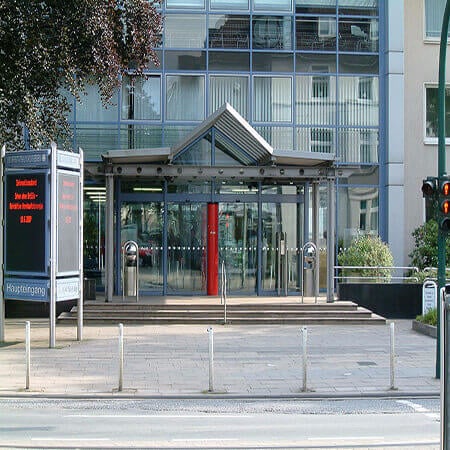Tetralogy of Fallot (TOF) implies the complex of inborn heart anomalies. Circulatory insufficiency that accompanies the pathology causes breathing impairment, fainting, general weakness, restlessness, and lethargy. A surgical intervention often helps resolve those issues, and children recover.
Content
- What is the tetralogy of Fallot?
- Types of blood flow impairment in tetralogy of Fallot
- Why does the TOF occur?
- The clinical picture of tetralogy of Fallot
- How is the tetralogy of Fallot diagnosed?
- Treatment for tetralogy of Fallot in Germany
- Prognosis
- The cost of treatment in Germany
- Treatment in hospitals in Germany
What is the tetralogy of Fallot?
Regarding the four aspects, the tetralogy of Fallot (TOF) is a malformation with reduced pulmonary blood flow. The condition includes the following medical diagnoses:
- Pulmonary artery stenosis. Valve stenosis is not uncommon, but there may be a decrease in the lumen of the right ventricular outlet (subclavian stenosis), or the pulmonary artery (subclavian stenosis).
- Interventricular septal defect. In the tetralogy of Fallot, there is a disruption of the integrity of the upper part of the septum (subaortic defect).
- Pathological displacement of the aorta. The outlet into the aorta is located closer to the right ventricle (aortic dextraposition).
- Compensatory hypertrophy of the right ventricle developing as a consequence of its overload.
Hemodynamics in such patients depend on the severity of septal defect and pulmonary artery stenosis. In a smaller part of patients with a mild defect, the signs of pulmonary artery stenosis prevail. If stenosis is severe, there is right-to-left effusion with cyanosis and prolonged systolic murmur. If stenosis is mild, a left-to-right shunt predominates, cyanosis is absent, lung blood filling is increased, and a systolic murmur is heard. Patients with this heart defect lag behind in development, they have early cyanosis, dyspnea on exertion.
Congestive heart failure is not very characteristic, since the septal defect allows to unload the great circle of the circulation with pronounced stenosis. This heart disease is characterized by the development of the so-called dyspnea-cyanotic attacks, which can be short and relatively mild, but can lead to coma and severe impairment of the cerebral circulation. The development of severe weakness after physical exertion is characteristic of the tetralogy of Fallot. More severe patients are observed to have a forced posture at rest: they squat or lie with their legs brought to the abdomen. This posture probably favors the return of venous blood to the heart that contains more oxygen, which reduces the hypoxemia in the great circle. Patients with this heart condition are often disturbed by attacks of retrosternal pain, headaches, dizziness.
Although angiocardiography and cardiac cavity probing are crucial in the diagnosis of tetralogy of Fallot (TOF), increasingly often sufficient information can be obtained by Doppler cardiography. A special analysis of the results of intraoperative examination, angiography and echocardiography revealed that in some patients with tetralogy of Fallot, echocardiography can sufficiently determine the diameter of the pulmonary artery fibrous ring and its trunk, as well as identify indications for surgery in case of the necessity for radical correction of malformation.
Types of blood flow impairment in tetralogy of Fallot
Venous blood from the hollow veins enters the right atrium. There, blood flows in two ways: the first is through a significant defect into the aorta and further into the great circle of circulation, and the second is through the pulmonary artery, narrowed in the initial section, with the resistance being much higher. Therefore, a smaller volume of venous blood enters the circulation, i.e. through the lungs, and a larger volume immediately enters the aorta, where it mixes with arterial blood.
A part of deoxygenated venous blood leads to a total lack of oxygenation. The degree of this process directly corresponds to the volume of deoxygenated blood that enters the circulation, and on the triggering of "defense mechanisms", multiplying the number of circulating red blood cells and hemoglobin.
An atypical health condition implies relatively small resistance to blood ejection into the lungs, there is left-right discharge, and the pulmonary blood flow decreases insignificantly. In such patients, the severity of obstruction may progress over time, causing crossed, and then persistent, right-left effusion and transforming the pathology into cyanotic form.
Thickening of the right ventricular muscle wall in comparison with the physiological thickness is exclusively a compensatory response to a significantly increased load.
Anatomical variants of right ventricular outflow tract narrowing include:
- Isolated infundibular (subclavian) (26%). It is a limited narrowing of the right ventricular exit tract in the "hourglass" type.
- Infundibular in combination with valvular narrowing (26%).
- Infundibular combined with valve and annular narrowing (16%).
- Diffuse underdevelopment of the right ventricular exit tract (27%).
- Predominant valvular stenosis (rare form characterized by moderate infundibular stenosis) (5%).
Why does the TOF occur?
Tetralogy of Fallot (TOF) is a congenital health condition formed in the womb during the 2nd-8th weeks of pregnancy when the embryo is forming all of its anatomical systems and organs. If a woman takes sleeping pills, sedatives, or hormonal medication at this time, the risk of heart defect occurrence increases.
Infectious diseases such as rubella, measles, scarlet fever, occurring in the first months of pregnancy, cause the birth of a child with tetralogy of Fallot. In addition, the formation of cardiac abnormalities is influenced by alcohol and drug consumption, or significant physiological stress. Sometimes the cause of the development of abnormalities is a hereditary factor.
The clinical picture of tetralogy of Fallot
Tetralogy of Fallot refers to such heart defects in which cyanosis develops, and it occurs gradually. In some cases, cyanosis is hardly noticeable, and only hemoglobin and erythrocyte levels may indicate a permanent lack of blood oxygenation (sometimes the term "white tetralogy" is used), but this does not change the essence of the malformation itself.
Immediately after birth, the child has no impairment regarding the health condition, but a few days later, his restless behavior, shortness of breath with little physical activity draws attention.
Cyanosis of the skin may be almost invisible or appear only when the child is crying and/or physically active. The child normally gains weight and normally develops. However, periodic sudden attacks of choking and rolling of the child's eyes draw attention. During such an attack, it is difficult to determine whether the child is conscious. An attack may last from a few seconds to several minutes and ends as spontaneously as it began. A breathless cyanotic seizure poses a danger, even if it is of a very short duration, and can provoke unfavorable consequences.
In the tetralogy of Fallot, dyspnea during cyanotic attacks, as one manifestation of the clinical symptomatology, may occur even in the absence of progression of cyanosis. Cyanosis in this malformation mostly occurs in the second half of life, and in some cases, it occurs later in life. At the same time, seizures are not a necessary clinical symptom of tetralogy of Fallot, their occurrence depends on the severity of right ventricular exit tract narrowing, which, as a rule, is individual for each patient.
In the presence of severe hypoxemia, retardation in physical development is noted. Cyanosis of the skin appears shortly after birth and gradually increases (if pronounced cyanosis occurs in the delivery room or the hours following birth, it is most likely that the child has a tetralogy of Fallot with pulmonary atresia).
How is the tetralogy of Fallot diagnosed?
The medical diagnosis of congenital malformation is made based on characteristic clinical symptoms, physical examination (systolic tremor along with the upper and middle third of the left sternum, characteristic murmurs that are heard above the heart and lung fields), and laboratory tests (clinical blood test reveals erythrocytosis, increased hemoglobin levels; the acid-base status test shows increased lactate levels, metabolic acidosis). In addition, instrumental studies are performed, which may include electrocardiography, chest radiography, echocardiography (one-dimensional, two-dimensional, Doppler-echocardiography).
To detect anomalies of the pulmonary arteries, computed tomography angiography is performed.
Diagnostic catheterization of the heart cavities may be the method of choice to determine the anatomical features of the malformation (performed on strict individual indications).
Treatment for tetralogy of Fallot in Germany
Intensive drug therapy and the use of oxygen therapy help to achieve temporary compensation for the defect, but cannot serve as a permanent solution to the medical problem. Surgery is indicated during the first year of the child's life. Depending on birth weight, great vessel maturity, and the patient's general state of health, the heart surgery department will decide whether to perform a one-stage or a two-stage surgical treatment for the defect.
The one-stage procedure includes correction of interventricular septal defect and enlargement of the area of pulmonary artery stenosis. Aortic dextroposition, when the pathological shunt is eliminated and the integrity of the heart valve is preserved, causes no significant effect on hemodynamics.
The two-stage treatment is used in children born prematurely and those with hypotrophy (low weight) or pulmonary hypoplasia. The method includes a palliative procedure to create an artificial anastomosis between the aorta and the pulmonary artery to increase blood flow to the lungs, allowing the child to emerge from the critical health condition. Subsequent heart surgery for definitive elimination of the malformation is performed when the patient reaches sufficient weight and the pulmonary trunk matures.
The choice of the type of heart surgery varies. For newborns and children in their first year of life, doctors perform palliative surgery to improve well-being and lower the risk of future complications from radical heart surgery. These are mainly bypass surgeries:
- A Blalock-Taussig anastomosis to the subclavian-pulmonary arteries.
- Central aortopulmonary anastomosis using a biological or synthetic prosthesis.
- Balloon valvuloplasty for the elimination of arterial stenosis.
After the child is 1,5-3 years old, radical surgery is prescribed to eliminate the ventricular septal opening. A patch of synthetic materials is placed at the place of ventricular conjunction.
Due to the most precise diagnostic methods and the effectiveness of surgical treatment, the specialists of the hospitals in Germany successfully perform operations to eliminate heart defects of the tetralogy of Fallot. Children are given a chance to grow and develop normally, to withstand physical exertion, and to lead a full life. If surgery to correct the defects is successful, which is most often the case, patients live to be 40 years old. They should be regularly monitored by a cardiologist and receive treatment to prevent possible complications.
The hospitals in Germany provide patients with high-quality postoperative care that prevents the development of complications after major open heart surgery. The comprehensive treatment in the best hospitals in Germany guarantees a favorable prognosis for the tetralogy of Fallot.
Prognosis
Without surgical treatment, the patient often lives for several years (average life expectancy is 12 years), but his health condition will continuously worsen: cyanosis becomes more pronounced, children look emaciated, and significantly lag behind their peers in physical development. Without therapeutic measures, approximately 30% of patients live for 10 years. A high mortality in the first weeks of life occurs with severe pulmonary vascular hypoplasia. In the older age group, the main cause of lethal outcomes is the occurrence of heart failure, and extremely severe arrhythmias.
Patients who underwent timely surgical intervention manage to achieve the complete elimination of tetralogy of Fallot.
The cost of treatment in Germany
The affordable cost of treatment in Germany is one of the advantages for foreign citizens. The combination of reasonable prices and high quality of services is not as common today as we would like it to be.
The final prices include the cost of treatment, consultations, diagnostic examinations, and rehabilitation procedures. You will be able to find out more about it after the doctors have discussed your clinical situation. Below you will find the list of prices for medical services in Germany:
- The prices for tetralogy of Fallot diagnosis start at 485 EUR.
- The cost of treatment with complete intracardiac repair surgery starts at 14,040 EUR.
- The prices of cardiac rehabilitation in hospitals in Germany start at 566 EUR.
Booking Health will help you find a medical center that is ideally suited to your financial situation.
Treatment in hospitals in Germany
Cardiac surgeons working in hospitals in Germany use effective methods to treat congenital heart pathologies, among which tetralogy of Fallot occupies a special place. This disease poses a serious threat from the moment of birth. The treatment for the tetralogy of Fallot requires not only a highly professional approach but also the most modern medical equipment, which guarantees the accuracy of diagnostics and safety of surgical interventions. The excellent technological base of hospitals in Germany allows performing surgical procedures of any degree of complexity.
The best-reviewed hospitals for tetralogy of Fallot treatment in Germany are considered to be:
- University Hospital Oldenburg.
- University Hospital of Ludwig Maximilian University of Munich.
- University Hospital Frankfurt am Main.
- HELIOS Heart Surgery Clinic Karlsruhe.
- Hospital Kassel.
- University Hospital Muenster.
You can contact Booking Health for assistance in hospital selection. More information about the mentioned hospitals can be found in the hospital section of the Booking Health website.
Authors:
This article was edited by medical experts, board-certified doctors Dr. Nadezhda Ivanisova, and Dr. Bohdan Mykhalniuk. For the treatment of the conditions referred to in the article, you must consult a doctor; the information in the article is not intended for self-medication!
Our editorial policy, which details our commitment to accuracy and transparency, is available here. Click this link to review our policies.














